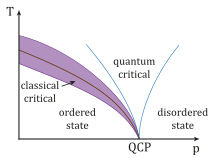Spin gapless semiconductor
Spin gapless semiconductors are a novel class of materials with unique electrical band structure for different spin channels in such a way that there is no band gap (i.e., 'gapless') for one spin channel while there is a finite gap in another spin channel.
| Condensed matter physics |
|---|
 |
| Phases · Phase transition · QCP |
|
Solid · Liquid · Gas · Plasma · Bose–Einstein condensate · Bose gas · Fermionic condensate · Fermi gas · Fermi liquid · Supersolid · Superfluidity · Luttinger liquid · Time crystal |
|
Phase phenomena |
|
Electronic phases Electronic band structure · Plasma · Insulator · Mott insulator · Semiconductor · Semimetal · Conductor · Superconductor · Thermoelectric · Piezoelectric · Ferroelectric · Topological insulator · Spin gapless semiconductor |
|
Electronic phenomena |
|
Magnetic phases |
|
Scientists Van der Waals · Onnes · von Laue · Bragg · Debye · Bloch · Onsager · Mott · Peierls · Landau · Luttinger · Anderson · Van Vleck · Mott · Hubbard · Shockley · Bardeen · Cooper · Schrieffer · Josephson · Louis Néel · Esaki · Giaever · Kohn · Kadanoff · Fisher · Wilson · von Klitzing · Binnig · Rohrer · Bednorz · Müller · Laughlin · Störmer · Yang · Tsui · Abrikosov · Ginzburg · Leggett |
In a spin-gapless semiconductor, conduction and valence band edges touch, so that no threshold energy is required to move electrons from occupied (valence) states to empty (conduction) states. This gives spin-gapless semiconductors unique properties: namely that their band structures are extremely sensitive to external influences (e.g., pressure or magnetic field). [1]
Because very little energy is needed to excite electrons in an SGS, charge concentrations are very easily ‘tuneable’. For example, this can be done by introducing a new element (doping) or by application of a magnetic or electric field (gating).
A new type of SGS identified in 2017, known as Dirac-type linear spin-gapless semiconductors, has linear dispersion and is considered an ideal platform for massless and dissipationless spintronics because spin-orbital coupling opens a gap for the spin fully polarized conduction and valence band, and as a result, the interior of the sample becomes an insulator, however, an electrical current can flow without resistance at the sample edge. This effect, the quantum anomalous Hall effect has only previously been realised in magnetically doped topological insulators.[1]
As well as Dirac/linear SGSs, the other major category of SGS are parabolic spin gapless semiconductors.[2] [3]
Electron mobility in such materials is two to four orders of magnitude higher than in classical semiconductors.[4]
SGSs are topologically non-trivial.[2]
Prediction and discovery
The spin gapless semiconductor was first proposed as a new spintronics concept and a new class of candidate spintronic materials in 2008 in a paper by Xiaolin Wang of the University of Wollongong in Australia.[5] [6] [7]
Properties and applications
The dependence of bandgap on spin direction leads to high carrier-spin-polarization, and offers promising spin-controlled electronic and magnetic properties for spintronics applications.[8]
The spin gapless semiconductor is a promising candidate material for spintronics because its charged particles can be fully spin-polarised, so that spin can be controlled via only a small applied external energy.[1]
References
- "Spin gapless semiconductors: Promising materials for novel spintronics and dissipationless current flow | ARC Centre of Excellence in Future Low-Energy Electronics Technologies".
- "Recent advances in Dirac spin-gapless semiconductors". Cite journal requires
|journal=(help) - Wang, Xiaotian (2018). "Search for a new member of parabolic-like spin-gapless semiconductors: The case of diamond-like quaternary compound CuMn2InSe4". Applied Physics Reviews.
- Wang, Xiao-Lin (2016). "Dirac spin-gapless semiconductors: Promising platforms for massless and dissipationless spintronics and new (quantum) anomalous spin Hall effects". National Science Review. 4 (2): 252–257. arXiv:1607.06057. doi:10.1093/nsr/nww069.
- Wang, Xiaolin (18 April 2008). "Proposal for a New Class of Materials: Spin Gapless Semiconductors". Physical Review Letters. 100 (15): 156404. Bibcode:2008PhRvL.100o6404W. doi:10.1103/physrevlett.100.156404. PMID 18518135.
- "Media Centre | University of Wollongong".
- "Gapless oxide semiconductors: Designer spin".
- "Half-Metals and Spin-Gapless Semiconductors". Cite journal requires
|journal=(help)